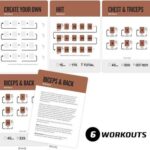https://weightliftingforpower.com/how-to-track-progress-using-barbell-exercise-cards/
Using Barbell exercise cards seem mysterious at first, but breaking them down isn’t too tricky. These are simple tools to help you keep track of your workout routines. They let you jot down what exercises you’re doing, how much weight you’re lifting, and, over time, how you’re improving. Think of them as your workout diary, but streamlined and focused on your barbell training.
While fitness tracking isn’t exactly a new concept, it has evolved significantly. Before the days of apps and digital trackers, folks used to scribble down their sets and reps on little notebooks or even scraps of paper. Barbell exercise cards take that old-school approach and make it more structured. They are tailored to your barbell lifts, emphasizing the essential data—weight, reps, and sets—that help assess your performance.
Why bother with these cards, though? Simply put, they’re straightforward and get you into the habit of holding yourself accountable. By routinely jotting down your workouts, you’re building a picture of progress, identifying patterns, and recognizing where you need to push harder. It’s not just about logging; it’s about reflecting and planning your next move.
One of the big draws of using these cards is how they keep you consistent. When motivation wanes, seeing tangible progress recorded can remind you why you started. They’re like having a personal cheerleader, always ready to show you just how far you’ve come and motivate you to keep going.
Setting Goals for Effective Tracking
To truly maximize the benefits of barbell exercise cards, it’s essential to set clear, achievable goals. Why does this matter so much? Without goals, you’re unthinkingly through your workouts. Goals give you direction and something to aim for, and barbell cards become your map.
When you’re figuring out your fitness goals, think about what you want. It could be lifting a certain weight or improving overall endurance. Being specific helps. Instead of saying, “Get strong,” aim for “Increase deadlift by 20 pounds.” The more precise the target, the easier it is to track your journey toward it.
Keeping track of typical milestones, such as the number of reps or the maximum weight lifted, is key. These metrics are your checkpoints. They let you measure progress and adjust your routines effectively. Barbell exercise cards make this easy, letting you see improvements or identify where you might be plateauing.
A routine that aligns with your goals is crucial. Consider what exercises target your objectives and how frequently you should be doing them. With a plan in hand, barbell exercise cards help you stay on course. They’re like your workout GPS, ensuring every session is a step closer to smashing those fitness goals.
How to Use Barbell Exercise Cards Effectively
Setting up your barbell exercise cards might seem daunting initially, but it’s pretty straightforward once you get going. The key is starting each card with the basics: your exercise of choice, target weights, reps, and sets.

Using these cards isn’t just about jotting things down. They’re tools for analyzing your performance over time. When you take a close look at the data you’re collecting, patterns start to emerge. You might notice certain days when you’re stronger or see a gradual improvement in endurance. This kind of insight is invaluable.
Feedback plays a considerable role here. Don’t just record and forget. Use those numbers as feedback to adjust your workouts. If you’re not hitting the numbers you expected, consider what variables might be affecting you, like rest, diet, or technique. And, if you’re smashing your goals, it might be time to set new ones.
Like anything, there are pitfalls to avoid. One common mistake is fixating solely on the numbers and ignoring form or resting when needed. Overloading yourself can lead to injury, which no card can effectively track. Stay mindful of what your body is telling you, and use the cards to enhance your training, not dictate it.
Measuring Success and Staying Motivated

Defining fitness success isn’t a one-size-fits-all scenario. It’s personal, and it’s up to you to decide what it looks like. Is it hitting a certain weight or mastering a challenging movement? Whatever your goal, your barbell exercise cards are there to show you what you’ve accomplished so far.
Progress tracking is robust because it quantifies improvement, and seeing those numbers move in the right direction can be incredibly motivating. This tangible evidence backs up your hard work and signals when you’re ready to take the next step or reassess your approach.
Commitment isn’t always easy, especially when progress feels slow. Celebrating the small wins is essential—such as an extra rep or finally mastering a form. These moments are what keep motivation levels high, and they’re all laid out clearly on your exercise cards.

Finding like-minded folks can also be hugely beneficial. Sharing your journey with others creates a sense of community and offers additional motivation. Whether it’s a friendly competition or simply sharing milestones, connecting through fitness often brings extra encouragement.
Remember, the journey is ongoing. Barbell exercise cards help you keep track of where you’ve been, but they also point you toward where you’re going. Keep looking ahead, stay committed to your goals, and trust in the process of continual improvement.
https://weightliftingforpower.com/bodyweight-exercises/
https://weightliftingforpower.com/the-best-barbell-exercise-card-sets/
https://weightliftingforpower.com/customizing-your-barbell-exercise-cards/
